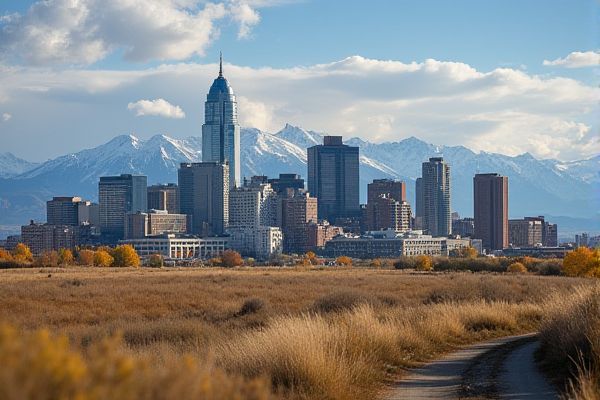
Safety and crime rates in Colorado: Overall crime rates below national average. Urban areas have higher crime levels. Low violent crime in rural communities. Focus on property crime in metro areas. Denver's crime rates higher than statewide average. Neighborhood watch programs are prevalent. Cannabis regulation impacts crime statistics. Emergency response services well-established. Active community policing in many areas. Crime rate trends vary across cities.
Overall crime rates below national average.
In recent statistics, Colorado's overall crime rates demonstrate a positive deviation from the national average, showcasing a more secure living environment. The state's violent crime rate stands at 368 offenses per 100,000 people, while its property crime rate is 2,357 offenses per 100,000 people. These figures stand in favorable contrast to the national rates of 379 for violent crimes and 2,487 for property crimes. For a comprehensive analysis of the safest cities in Colorado and to understand what makes them stand out, you can visit the detailed blog on the Reolink website.
Urban areas have higher crime levels.
Urban areas in Colorado, such as the Denver metro area, including cities like Aurora, Lakewood, and Glendale, and Colorado Springs, have significantly higher crime rates compared to rural areas, particularly in theft, burglary, and violent crimes. For more detailed information on crime rates and the safest cities in the region, visit SafeHome.
Low violent crime in rural communities.
Contrary to the notion that rural communities are safer, gun violence rates in rural areas of the U.S., including those in Colorado, have been found to match or even outpace those in urban areas. The National Criminal Justice Association reports that rural communities experience a 40% higher age-adjusted gun death rate compared to large metropolitan areas.
Focus on property crime in metro areas.
In Colorado, metro areas such as the Denver Metro, which includes Aurora, Lakewood, and Glendale, and the Pueblo metro area, have some of the nation's highest property crime rates. The Denver Metro had the highest motor vehicle theft rate, and Glendale has the second-highest property crime rate in the country, with over 20,000 property crimes per 100,000 people. For more detailed information, you can visit the SafeHome website which provides insights into these statistics.
Denver's crime rates higher than statewide average.
Denver's crime rates are significantly higher than the statewide average, with a violent crime rate more than double the national median and a property crime rate far exceeding both state and national averages, making it one of the most crime-dense cities in the U.S. In recent years, the crime rate in Denver has risen substantially, driven by motor vehicle thefts and property crimes. Currently, it is 58% higher than the Colorado average, with crimes against persons and property consistently outpacing state figures. These alarming statistics highlight the ongoing challenges Denver faces in ensuring public safety and curbing the rise of criminal activities within the city.
Neighborhood watch programs are prevalent.
Neighborhood Watch programs in Colorado, such as the one in Colorado Springs, are prevalent and serve as a crime prevention partnership between the community and the police, focusing on identifying and reporting suspicious activity, improving home security, and enhancing community cohesion to reduce crime and improve quality of life.
Cannabis regulation impacts crime statistics.
The legalization of marijuana in Colorado has led to a significant decrease in marijuana-related arrests, with a 68% reduction from 2012 to 2019, and a decline in court filings by 55% over the same period. However, the arrest rate for Black individuals remains disproportionately high, and there has been no substantial increase in major crimes such as violent or property crimes, with some studies suggesting a crime-reducing effect in neighboring states and local neighborhoods. For more in-depth insights, you can view the comprehensive report on the consequences of marijuana legalization.
Emergency response services well-established.
Colorado has well-established emergency response services, with the Division of Homeland Security and Emergency Management (DHSEM) supporting all hazards and disasters through comprehensive emergency management programs, including prevention, protection, mitigation, response, and recovery, and coordinating with local and state agencies.
Active community policing in many areas.
In Colorado, active community policing is a cornerstone of public safety, with police departments like Johnstown's engaging in neighborhood patrols, problem-solving partnerships, and open communication to build trust and address community concerns, thereby enhancing safety and reducing crime. Similar community policing initiatives are also implemented in other areas, such as Canon City, where the Police Department fosters community partnerships and utilizes various programs to prevent crime and improve public safety.
Crime rate trends vary across cities.
Crime rates in Colorado vary significantly across cities, with areas like Glendale and the Pueblo metro having some of the highest property and violent crime rates, while other cities show different trends, highlighting the need to consider local statistics when assessing safety. For a comprehensive understanding of which areas stand out as the safest in the state, the SafeHome website offers detailed information and rankings of cities based on various crime metrics.
